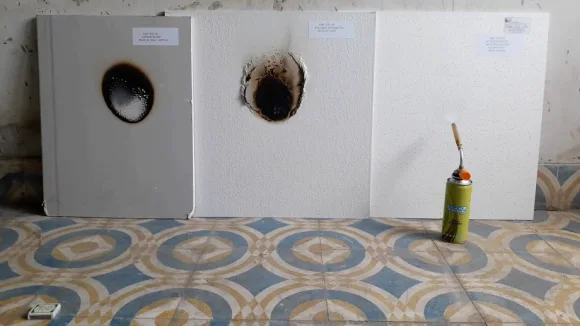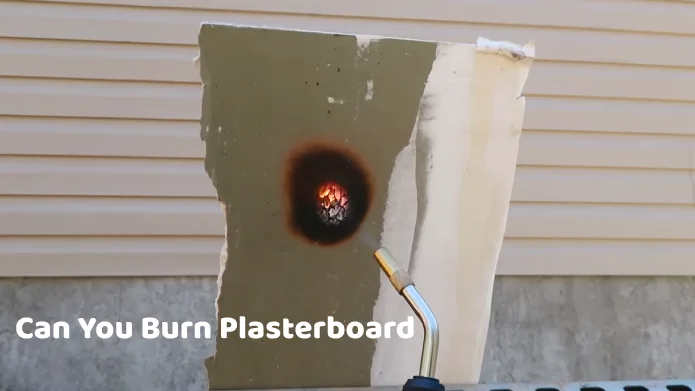Last Updated on June 4, 2023
Plasterboard is a highly utilized and popular building material in the construction industry. It is known for its durability, affordability and installation convenience, making it a go-to choice for many builders. But, concerns have been raised regarding the flammability of the plasterboard. Can it burn?
The answer is yes, it can. But to avoid negative consequences and promote a safe environment, it’s recommended that we do not burn plasterboard. Understanding how this material reacts to fire is crucial for ensuring the well-being of buildings and their occupants.
While plasterboard isn’t completely fire-resistant, it possesses fire-resistant qualities that can help slow the spread of flames. Discover the truth about plasterboard and fire with this detailed analysis. Explore its flame reaction, fire rating, and burning temperature.
How Does Plasterboard React to Fire?

When exposed to fire, plasterboard reacts in several ways. It can smolder, burn slowly, or be ignited quickly. Among the most common reactions are:
ONE: Fire Resistance
Gypsum-based materials like plasterboard play a critical role in ensuring the fire safety of buildings. Gypsum contains chemically bound water released when exposed to fire, slowing down the spread of flames.
The fire resistance of the plasterboard varies based on thickness and the number of layers used. Despite this, two layers of fire-resistant plasterboard on each side of a partition can provide up to two hours of fire resistance. Therefore, it is a good material for buildings that need to remain fire safe.
This added protection can prevent the spread of fire and provide occupants with valuable evacuation time.
TWO: Impact on CFD Simulations
Gypsum dehydration in plasterboard during a building fire can release significant water vapor. This can lead to inaccurate CFD simulations and endanger occupants by affecting thermal properties and airflow patterns.
Accurate modeling of gypsum dehydration is crucial in improving the safety of residential buildings. Although, it requires detailed knowledge of material properties and complex physical and chemical processes.
Further research is necessary to enhance our comprehension of this phenomenon and its impact on building fire behavior.
THREE: Environmental Impacts
There are significant environmental impacts from gypsum dehydration during fires. Gypsum is commonly used in plasterboard, and when burned, it produces toxic gas that pollutes the air. Disposing of gypsum with biodegradable wastes also generates toxic gas, which has a considerable environmental impact.
Also, the production, transportation, and plasterboard disposal leave negative environmental footprints. Therefore, exploring alternative materials and disposal methods becomes essential.
What fire rating is plasterboard?
Fire-rated plasterboard must have a class 1 rating, which indicates it has been tested for its surface spread of flames. This rating means the plasterboard has the lowest possible level of flame spread due to its glass fibers that slow down the fire’s progress.
It’s worth noting that while fire-rated plasterboard does not offer fireproofing, it can provide occupants more time to evacuate and inhibit the fire’s spread. When choosing plasterboard for construction, selecting a material that meets the necessary fire rating requirements is crucial to ensure safety.
How long does the plasterboard take to burn?

Several elements, including the board’s thickness, fire type, and insulation, influence how long it takes a plasterboard to burn. 12.5mm thick Plasterboard appropriately installed can take up to 30 minutes to burn.
In the event of a fire, this material creates a barrier that slows the fire’s spread, giving occupants more time to leave the building. A qualified professional is necessary to ensure the proper use of plasterboard for the safety of your building because burn times are subject to additional factors.
What temperature does the plasterboard burn?
To ensure proper fire resistance in buildings, it’s important to understand the temperature at which drywall will combust. Drywall’s paper covering can ignite at 451°F, but the gypsum interior will only combust at much higher temperatures.
This is due to the moisture in the gypsum evaporating before combustion occurs. The exact temperature at which the plasterboard will burn depends on the drywall type, insulation presence, and fire intensity.
However, it’s generally agreed that plasterboard is a relatively fire-resistant material, as it takes extremely high temperatures to ignite the gypsum.
Where do you use fireproof plasterboard?
Fireproof plasterboard is utilized in areas with a higher fire risk within a property, with the kitchen being a primary example. In industrial settings, thicker fireproof plasterboard can be implemented to prevent fire from spreading for several hours.
It is crucial to evaluate potential hazards and take necessary precautions by implementing fireproof plasterboard in suitable locations. Employing fireproof plasterboard can limit the extent of damage caused by a fire.
Can heat pass through the plasterboard?

Heat can easily pass through plasterboard both inwards and outwards, as external walls often lack insulation. As a result, during summertime, the wall absorbs the sun’s radiant heat and transmits it through the plasterboard into your living areas.
Conversely, warm air inside the home will pass through the plasterboard and out through the external wall in winter. It is important to note that proper insulation can significantly reduce these heat losses and gains, creating a more comfortable and energy-efficient living environment.
Safeguard Your Property with Fire-Resistant Plasterboard
Plasterboard is a widely used construction material due to its affordability and versatility, but its fire safety properties need to be considered. Plasterboard has a fire rating that indicates its ability to resist flames, but it can release hazardous smoke and toxic gases when exposed to fire.
Fire-resistant plasterboard can resist fire for up to 120 minutes, making it suitable for high-risk areas such as kitchens and garages. Careful installation following the manufacturer’s instructions is crucial to ensure optimal performance in case of a fire emergency.
It is essential to use fire-resistant plasterboard in areas where fire safety is a concern to prevent the spread of fire and ensure the safety of individuals. Planning for fire safety measures during construction can prevent property damage and save lives.



